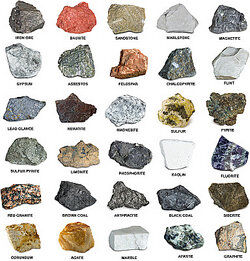
The three basic types of rocks are igneous, metamorphic and sedimentary. Sedimentary rocks make up most of the rocks on the earth and are formed when bits of rock, soil or organic matter settles and accumulates. Plant and animal fossils can be found in sedimentary rock. When there is an abundance of plants and animals, fossil fuels develop, like oil, natural gas and coal. Types of sedimentary rocks include carbonate rocks, chemically precipitated rocks, clastic rocks and coal.
Examples of Sedimentary Rocks
Carbonate rocks are made mostly of carbonate minerals, coming from of bioclasts created by calcareous organisms, such as corals or mollusks. Limestone and dolostone make up the majority of carbonate rocks.
Carbonate Rocks
- algal limestone
- bafflestone
- beachrock
- biocalcarenite
- biomicrite
- biosparite
- boundstone
- calcarenite
- calcilutite
- chalk
- coquina
- dolomitic limestone
- dolostone
- grainstone
- limestone
- micrite
- microbialite
- microcrystalline limestone
- oolitic limestone
- packstone
- rudstone
- travertine
- wackestone
Chemically Precipitated Rocks
Chemically precipitated rocks are often formed when water evaporates and leaves minerals behind. For example:
- banded iron formations
- chert
- duricrust
- evaporites
- ferricrete
- flint
- gypsum
- iron formations
- ironstone
- jasperoid
- jaspilite
- phosphate rocks
- salt
- silcrete
- siliceous sinter
- sylvinite
- taconite
- tufa
- weathering crust
Clastic Rocks
Clastic rocks are made up of soil and tiny pieces of rocks called clasts. They accumulate and then are subjected to compaction and cementation. The soil and rocks are broken down my physical weathering, such as heat, ice, pressure and water. For example:
- alum shale
- arenite
- argillite
- arkose
- bentonite
- black shale
- cinerite
- claystone
- conglomerate
- diamictite
- diatomite
- eolianite
- fanglomerate
- gaize
- graywacke
- lignite
- litharenite
- marl
- mudstone
- novaculite
- orthoquartzite
- porcellanite
- quartz arenite
- quartz-pebble conglo
- radiolarite
- red beds
- sandstone - including itacolumite and gritstone
- shale
- siltstone
- siltstone
- sparagmite
- spongolite
- subarkose
- subgraywacke
- sublitharenite
- tillite
- tilloid
- tonstein
- sedimentary breccia
- volcaniclastics
Coal
When pressure and temperature increase, chemical reactions are stimulated. Organic material containing carbon can become coal. Here are examples:
- anthracite
- bituminous coal
- humic coal
- sapropelite
- steam coal
- subbituminous coal
Other Types of Sedimentary Rocks
- anhydrite
- bauxite
- breccia
- breccia shell beds
- bone beds
- calcrete - also called caliche, hardpan, kankar or duricrust
- caustobiolith
- contourite
- floatstone
- flysch
- gas sands
- grapestone
- greensand
- kukersite - a type of oil shale
- laminite
- laterite
- megabreccia
- microbreccia
- molasse
- oil sands
- oil shale
- oolite
- pozzolan
- merate
- siliciclastics
- tempestite
- tidalite
- torbanite
- tripoli
- turbidite
Sedimentary Basins
Sedimentary basins are areas where sedimentation occurred on a large scale. Examples include:
- Rift basin - Examples are San Luis, Espanola, and Albuquerque basins of the Rio Grande Rift and the Fundy Basin in Canada
- Sag basin - A sag basin forms along faults and several can be found along the San Andreas Fault in California
- Fore-arc basin - These basins are found in the ocean where trenches formed from tectonic movement and then filled with sediment
- Foreland basin - Foreland basins are formed when continents collide and a shallow basin forms.
- Back-arc basin - These submarine basins are formed when the edge of a continent collapses or when an oceanic trench moves. An example is the Sea of Japan.
Different sedimentary rock examples can be found worldwide; but, the basic process that constructs the rocks remains the same.